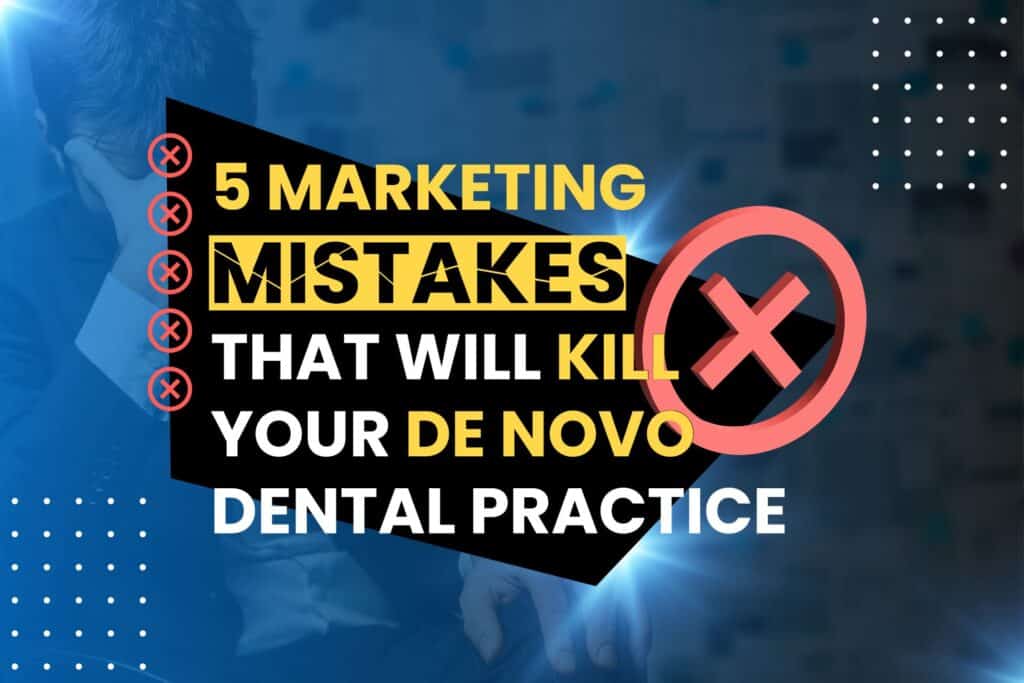New dental practices often struggle to create new patients.
Some de novo owners are fresh out of dental school and simply don’t know much about marketing. DDS programs may offer outstanding clinical training, but most do little to prepare graduates for the business side of dentistry.
However, even established dental group leaders often find that generating patients for a brand-new practice is difficult. Growth is a different animal when you’re starting from scratch without a steady stream of existing patients and referrals to rely on.
Let’s go through 5 key mistakes that I’ve seen de novos make again and again. Solve them and you’ll be well on your way to creating a predictable new patient flow.
👉 Get the Dental Marketing Digest: 5 powerful NP growth tips in your inbox each month.
Mistake #1: You don’t know your cost per lead (CPL)
Generating leads — or getting people to contact your practice to learn more about scheduling an appointment — is the primary goal of most dental marketing.
However, not all dental marketing is created equal. Some campaigns are more effective than others, and being able to tell the difference between marketing that works and a campaign that’s simply wasting your ad dollars is essential.
Which brings us to cost per lead.
- Cost per lead or CPL is the single best KPI for measuring the performance of your ad campaign (and related factors like your website).
- CPL tells you exactly how much it costs to use digital marketing to get someone to contact your practice looking for an appointment.
- To calculate your CPL, divide your monthly marketing budget by the number of marketing leads you’ve generated over the last month.
Unfortunately, most de novo owners have no idea what their CPL is. And if they do, they’re doing the math wrong by including non-marketing patients when calculating.
This means that they also have no idea whether their marketing is actually effective. If you want to do things differently and build marketing that delivers a steady stream of new patients as efficiently as possible, then you need to start by keeping a weather eye on your CPL.
Target CPL range
Ideally, most GP dentists will want to target a CPL of $140 to $240 depending on market size. Full arch will likely be in a similar range.
👉 Learn more: Try these simple tips to grow your dental practice.
Mistake #2: You don’t know your cost to acquire a patient (CAC)
If CPL is the best way to measure how well your ads and website are working to generate leads for your practice, then your CAC (cost to acquire a patient) does the same thing for your marketing campaign as a whole.
- CAC is a catch-all figure that tells you exactly how much it costs to get a person to not only call your office but become a paying patient.
- Used in conjunction with CPL, it’s the gold standard for measuring the performance of your entire new patient funnel.
- To calculate your CAC, take your monthly marketing budget and divide it by the number of new marketing patients you’ve seen over the last month.
CAC can tell you which parts of your marketing are working and which aren’t. When you subtract your CPL from your CAC, you get a clear picture of your conversion costs, or exactly how much you’re spending to turn a lead into a patient.
Here’s how it works
Let’s say that your CAC (again, track this number using only your marketing patients) is $400. That’s on the high end but within the normal range.
Now let’s say that In this example, your CPL is only $150, which is excellent. But that means that when you subtract your CPL from your CAC to assess your conversion costs, you see that you’re spending $250 to turn each lead into someone in your waiting room.
In many markets, that’s too high.
Your data is telling you that you’re doing a great job generating leads. But you’re also fumbling the ball in the red zone by failing to convert those leads into appointments, scheduling patients too far out, or simply not doing enough to get folks who do schedule to actually show up.
What makes seeing this so powerful is that now you don’t have to waste money revamping your marketing. Instead, you can turn your attention towards fixing your conversion process by bringing in coaches to help your team learn how to do a better job converting phone calls, changing your approach to scheduling by fitting in new patients more quickly, adding in text or email appointment reminders, or taking whatever other action seems appropriate.
Conversely, if your data had shown you the opposite — a CPL that was too high coupled with a CAC that was fairly normal — then you’d know that you did have a marketing problem, and could put your energy and dollars in that direction.
Target CAC range
Most GPs aim for a CAC of $200 to $400, depending on market size. However, full-arch or implant dentists can expect to spend up to $5000 to acquire each patient.
👉 Learn more: Build a cohesive dental marketing strategy using our dental growth flywheel model.
Mistake #3: You don’t know your phone conversion rate
Ready for a shock? How you handle phone calls might be the single most important part of your marketing.
- The average dental practice misses 35 percent of phone calls.
- Many practices convert calls into scheduled appointments at only 50 percent.
- Do both and you’re throwing away 70 percent of your marketing budget on poor phone conversion.
In other words, whoever is answering the phones — and how often they answer — plays an enormous role in whether you’re getting any real value from your marketing efforts. If your front desk team (or your dedicated call team, if you’ve got one) isn’t trained in how to turn a call into a scheduled appointment, then it doesn’t matter how many leads you’re generating.
You’re going to throw most of them away.
So tracking your phone conversion rate is really important. To do this, divide your number of new patient appointments for marketing patients by your number of calls from marketing leads.
Once you’ve got reliable data here, you’ll be able to assess each call handler’s performance and get them coaching if they’re not up to snuff. (Don’t blame your team if they’re falling short in this area. Call conversion is a delicate art that takes training and practice.)
Again — and I know I’m beating a dead horse here — you need to make sure that you’re tracking phone conversion rates specifically for your marketing patients. Otherwise, you’ll be including data from referral patients or other callers who are essentially a guaranteed “Yes,” which will artificially inflate your overall performance stats.
Target phone rates
Your practice should aim to answer every single phone call. 100 percent. And with coaching, you should be able to achieve a phone conversion rate of 80 percent, if not higher.
👉 Get help: We can teach you how to convert more new patients.
Mistake #4: You don’t know your recare rate
You’ve spent hundreds of dollars to bring a new patient through your doors — all for a cleaning appointment that you only charge $150 for. Is this crazy?
Of course not, because you’ve got your eye on the long game. You know that even a hygiene patient is worth far more than $150 because they’ll keep coming back for more every six months.
But here’s the reality of the situation
- You can’t simply assume that a new hygiene patient will show up for their next cleaning (or follow-up of another kind).
- And you really can’t make that assumption if you’re dealing with a marketing patient.
Marketing patients are tricky. They’re shoppers, always on the lookout for a deal. They have little loyalty to your practice until after they’ve gotten to know you, which will probably take more than one appointment.
So even after you’ve seen a patient for that first cleaning, filling, or whatever else, your time spent measuring KPIs is not done. It’s critical that you do what many dentists don’t — which is track your recare rate or the number of marketing patients who show up for their second appointment (and more after that).
Recare is all about turning a transaction (that initial visit) into a lasting relationship. Creating that relationship is how you translate your initial marketing investment into long-term value (more on that in a moment) and generate an ROI that can result in you recouping your marketing dollars many times over.
If your recare rate is low, then you’ll want to take steps to protect your investment by getting more patients to keep coming back. This usually means doing everything from the basics, like making sure each patient schedules their next appointment before leaving your office, to more sophisticated techniques such as sending text message reminders the week and the day before a follow-up visit.
Target recare rate
Overall, we suggest aiming for a recare rate of at least 75 percent. If you’re not hitting that number, then you’ll know you need to take action.
Mistake #5: You don’t know the LTV or overall return on your marketing dollars
Since you’ve hung in this far, let’s end on a high note. Most dentists don’t know the long-term value or LTV of their marketing patients… which is a shame, because this number can be really fun.
- When you measure LTV, you’re tracking how much money each patient generates for your practice on an ongoing, rolling basis.
- If you’re consistent about taking steps to boost your recare rate, this number will usually continue to increase over time.
- Unless you specialize in one-off treatments like full arch, in which case you’ll see a much higher initial ROI but little to no long-term value.
For example, that hygiene patient we talked about who brought in $150 for their first appointment? At six months, their LTV is $300, or probably enough to cover your marketing investment. After a year, it should go up to $450.
And that’s assuming they’ve needed nothing but cleanings. Throw a few fillings in there and that LTV curve will climb even more sharply.
Now, it’s important to track LTV because it gives you a big-picture perspective on how much value you’re getting out of your marketing. It’s not unusual to see an average one-year LTV of at least 4 or 5 times your CAC, and if you’re getting less than that, you probably need to take action to optimize your marketing further (use the metrics we’ve already covered to help figure out where the problem is).
But watching your LTV data is also just plain satisfying. This is the payoff — where you get to see right there in black and white how all the hard work that you and your team have done is resulting in wins for your practice.
Target LTV range
Again, 4 to 5 times your CAC is a good number to aim for over a new patient’s first year under your care — and you’ll be well on your way to leading a practice that’s thriving, not just surviving.






